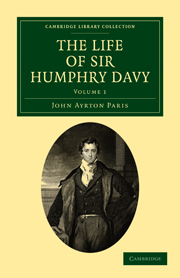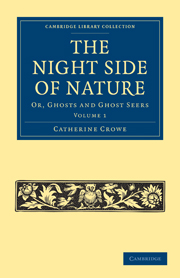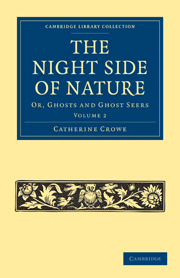Refine search
Actions for selected content:
10306 results in History of science: general interest

Illustrations of the Huttonian Theory of the Earth
-
- Published online:
- 07 September 2011
- Print publication:
- 19 May 2011
- First published in:
- 1802

Earthquakes and Other Earth Movements
-
- Published online:
- 07 September 2011
- Print publication:
- 09 June 2011
- First published in:
- 1886

The Life of Sir Humphry Davy
-
- Published online:
- 07 September 2011
- Print publication:
- 02 June 2011
- First published in:
- 1831

The Night Side of Nature
- Or, Ghosts and Ghost Seers
-
- Published online:
- 07 September 2011
- Print publication:
- 19 May 2011
- First published in:
- 1848

The Night Side of Nature
- Or, Ghosts and Ghost Seers
-
- Published online:
- 07 September 2011
- Print publication:
- 19 May 2011
- First published in:
- 1848

Sketches of the Royal Society and Royal Society Club
-
- Published online:
- 07 September 2011
- Print publication:
- 17 February 2011
- First published in:
- 1849

Personal Narrative of Travels to the Equinoctial Regions of the New Continent
- During the Years 1799–1804
-
- Published online:
- 07 September 2011
- Print publication:
- 02 June 2011
- First published in:
- 1814
Paul A. Elliott, Enlightenment, Modernity and Science: Geographies of Scientific Culture and Improvement in Georgian England. London and New York: I.B. Tauris, 2010. Pp. xii+363. ISBN 987-1-84885-366-9. £65.00 (hardback).
-
- Journal:
- The British Journal for the History of Science / Volume 44 / Issue 3 / September 2011
- Published online by Cambridge University Press:
- 08 September 2011, pp. 465-467
- Print publication:
- September 2011
-
- Article
- Export citation
Andrew Cunningham and Sachiko Kusukawa (eds.), Natural Philosophy Epitomised: Books 8–11 of Gregor Reisch's Philosophical Pearl (1503). Farnham: Ashgate, 2010. Pp. lxxiv+346. ISBN 978-0-7546-0612-3. £65.00 (hardback).
-
- Journal:
- The British Journal for the History of Science / Volume 44 / Issue 3 / September 2011
- Published online by Cambridge University Press:
- 08 September 2011, pp. 459-461
- Print publication:
- September 2011
-
- Article
- Export citation
Paul D. Brinkman, The Second Jurassic Dinosaur Rush: Museums and Paleontology in America at the Turn of the Twentieth Century. Chicago and London: University of Chicago Press, 2010. Pp. xiv+345. ISBN 978-0-226-07472-6. $49.00 (hardback).
-
- Journal:
- The British Journal for the History of Science / Volume 44 / Issue 3 / September 2011
- Published online by Cambridge University Press:
- 08 September 2011, pp. 469-470
- Print publication:
- September 2011
-
- Article
- Export citation
Ahmad Dallal, Islam, Science, and the Challenge of History. New Haven and London: Yale University Press, 2010. Pp. xii+239. ISBN 978-0-300-15911-0. £18.99 (hardback).
-
- Journal:
- The British Journal for the History of Science / Volume 44 / Issue 3 / September 2011
- Published online by Cambridge University Press:
- 08 September 2011, pp. 455-456
- Print publication:
- September 2011
-
- Article
- Export citation
Alan Chalmers, The Scientist's Atom and the Philosopher's Stone: How Science Succeeded and Philosophy Failed to Gain Knowledge of Atoms. Heidelberg, London and New York: Springer, 2009. Pp xii+287. ISBN 978-90-481-2361-2. £90.00 (hardback).
-
- Journal:
- The British Journal for the History of Science / Volume 44 / Issue 3 / September 2011
- Published online by Cambridge University Press:
- 08 September 2011, pp. 463-465
- Print publication:
- September 2011
-
- Article
- Export citation
Benjamin Wardhaugh, How to Read Historical Mathematics. Princeton and Oxford: Princeton University Press, 2010. Pp. xii+116. ISBN 978-0-691-14014-8. $22.95 (hardback).
-
- Journal:
- The British Journal for the History of Science / Volume 44 / Issue 3 / September 2011
- Published online by Cambridge University Press:
- 08 September 2011, pp. 456-458
- Print publication:
- September 2011
-
- Article
- Export citation
BJH volume 44 issue 3 Cover and Back matter
-
- Journal:
- The British Journal for the History of Science / Volume 44 / Issue 3 / September 2011
- Published online by Cambridge University Press:
- 08 September 2011, pp. b1-b7
- Print publication:
- September 2011
-
- Article
-
- You have access
- Export citation
María Portuondo, Secret Science: Spanish Cosmography and the New World. Chicago and London: University of Chicago Press, 2009. Pp. xiv+335. ISBN 978-0-226-67534-3. £31.00 (hardback).
-
- Journal:
- The British Journal for the History of Science / Volume 44 / Issue 3 / September 2011
- Published online by Cambridge University Press:
- 08 September 2011, pp. 462-463
- Print publication:
- September 2011
-
- Article
- Export citation
Books received
-
- Journal:
- The British Journal for the History of Science / Volume 44 / Issue 3 / September 2011
- Published online by Cambridge University Press:
- 08 September 2011, pp. 475-478
- Print publication:
- September 2011
-
- Article
- Export citation
Paul Glennie and Nigel Thrift, Shaping the Day: A History of Timekeeping in England and Wales 1300–1800. Oxford: Oxford University Press, 2009. Pp. xiv+456. ISBN 978-0-19-927820-6. £41.00 (hardback).
-
- Journal:
- The British Journal for the History of Science / Volume 44 / Issue 3 / September 2011
- Published online by Cambridge University Press:
- 08 September 2011, pp. 458-459
- Print publication:
- September 2011
-
- Article
- Export citation
Andrew Pattison, The Darwins of Shrewsbury. Stroud: The History Press, 2009. Pp. 127. ISBN 978-0-7524-4867-1. £14.99 (paperback). - Mike Dixon and Gregory Radick, Darwin in Ilkley. Stroud: The History Press, 2009. Pp. 126. ISBN 978-0-7524-5283-8. £12.99 (paperback).
-
- Journal:
- The British Journal for the History of Science / Volume 44 / Issue 3 / September 2011
- Published online by Cambridge University Press:
- 08 September 2011, pp. 467-468
- Print publication:
- September 2011
-
- Article
- Export citation
Alison Bashford and Philippa Levine (eds.), The Oxford Handbook of the History of Eugenics. Oxford: Oxford University Press, 2010. Pp. xxi+586. ISBN 978-0-19-537314-1. £85.00 (hardback).
-
- Journal:
- The British Journal for the History of Science / Volume 44 / Issue 3 / September 2011
- Published online by Cambridge University Press:
- 08 September 2011, pp. 472-473
- Print publication:
- September 2011
-
- Article
- Export citation
What needs to be explained about modern science?
-
- Journal:
- The British Journal for the History of Science / Volume 44 / Issue 3 / September 2011
- Published online by Cambridge University Press:
- 08 September 2011, pp. 449-454
- Print publication:
- September 2011
-
- Article
- Export citation
